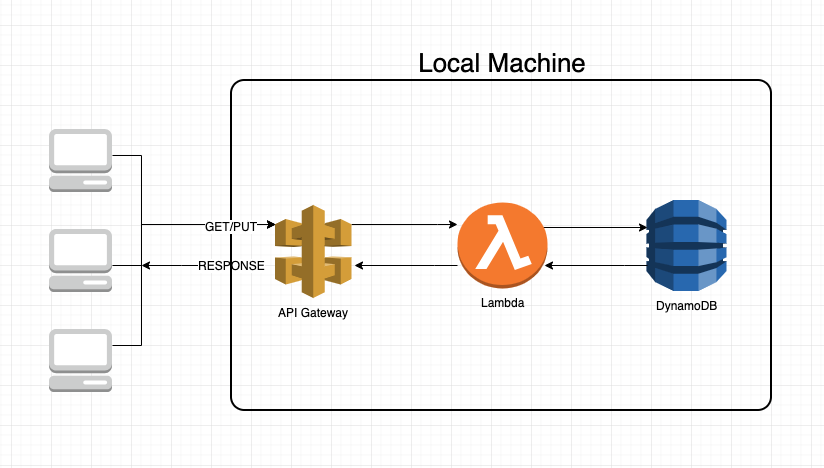A hands-on tutorial on using SAM with DynamoDB Local.
This repository contains an AWS Lambda function that puts and gets a Person record (First name, Last name, Age) to/from a local DynamoDB instance. The process flow is as follows:
- Install AWS CLI and configure the credentials.
- Docker installed
- SAM CLI
- Python 3.6/3.7 with boto3 package
- An AWS Account with permissions to IAM, CloudFormation, S3, Lambda, and DynamoDB (to deploy and test in a AWS region).
Please note:
a. I will be using the us-east-1 region (Virginia) for deploying this application, but you may deploy to any region where Lambda and DynamoDB are available.
b. User-specified input parameters will be marked with curly braces in the following instructions. For e.g., {s3-bucket-name} will need to be replaced with a bucket name of your choice, such as mybucketname etc.
-
Clone this repo and change to the directory 'sam-dynamodb-local'.
-
Start DynamoDB Local by executing the following at the command prompt:
docker run -p 8000:8000 amazon/dynamodb-local
This will run the DynamoDB local in a docker container at port 8000. -
At the command prompt, list the tables on DynamoDB Local by executing:
aws dynamodb list-tables --endpoint-url http://localhost:8000 -
An output such as the one shown below confirms that the DynamoDB local instance has been installed and running:
{
"TableNames": []
} -
At the command prompt, create the PersonTable by executing:
aws dynamodb create-table --cli-input-json file://json/create-person-table.json --endpoint-url http://localhost:8000Note: If you misconfigured your table and need to delete it, you may do so by executing the following command:
aws dynamodb delete-table --table-name PersonTable --endpoint-url http://localhost:8000 -
At the command prompt, start the local API Gateway instance by executing:
sam local start-api --env-vars json/env.json
-
Insert a Person item in the table by executing the following CURL command at the prompt:
curl -d '{"FName": "Henry", "LName": "McKenna", "Age": 10}' http://127.0.0.1:3000/This should output the partition key(GUID) of the item inserted into the local DynamoDB instance, such as:
12a72031-8b5c-4c76-8c90-83f3d5132088 -
Let's retrieve the item from the local DynamoDB instance by executing the following CURL command at the prompt:
curl -X GET -d ‘{“Id”:”12a72031-8b5c-4c76-8c90-83f3d5132088”}’ http://127.0.0.1:3000This will display the output as follows:
Henry McKenna 10
Note: You may alternatively use a GUI to view the items on the local DynamoDB instance, such as the DynamoDB Local Shell or DynamoDB Manager.
-
Create a S3 bucket for storing SAM deployment artifacts in the us-east-1 region (or a region of your choosing). Please note that you may not use '-' or '.' in your bucket name.
aws s3 mb s3://{s3-bucket-name} --region us-east-1 -
Create the Serverless Application Model package using CLI.
sam package \
--region us-east-1 \
--template-file template.yml \
--s3-bucket {s3-bucket-name} \
--output-template-file packaged.yml -
Deploy the packaged template.
aws cloudformation deploy \
--region us-east-1 \
--template-file packaged.yml \
--stack-name {stack_name} \
--capabilities CAPABILITY_IAM -
After the stack has been successfully created, you may test the application using the CURL commands as shown above.

